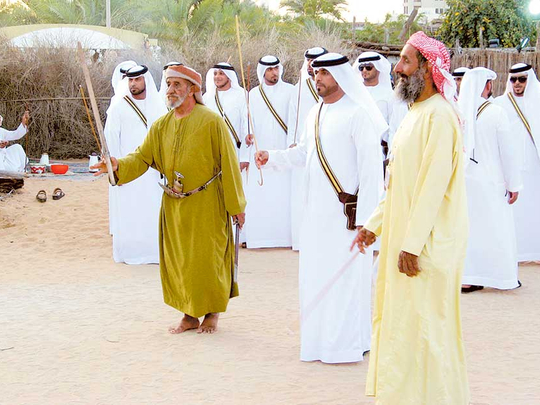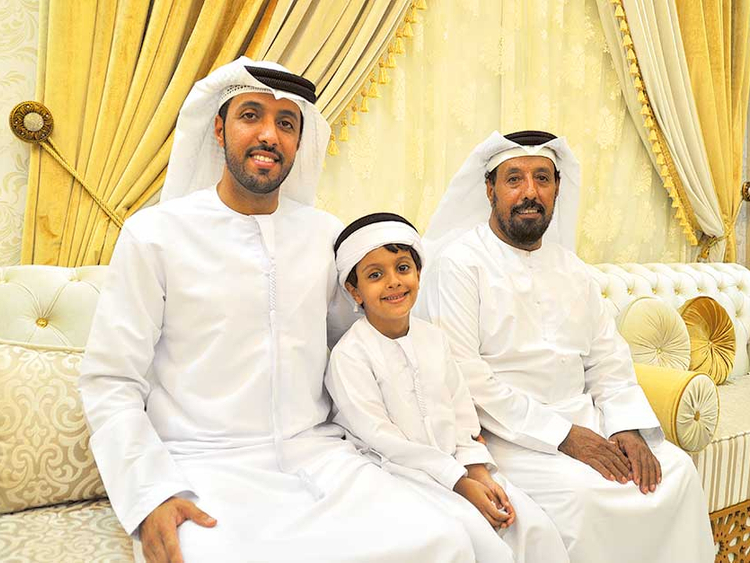
Abu Dhabi/Dubai: As the UAE celebrates Eid Al Fitr and the blend of modernity and tradition pervades the festivities, there are facets of Eid that hark back to the olden days and which remain etched in the minds of elderly Emiratis.
Emirati Rashid Obaid Al Tunaiji recalls how preparations for Eid Al Fitr would begin during the last ten days of Ramadan. They would travel on camel backs to the markets in Sharjah, Ajman or Dubai, while citizens in Al Ain used to go to the markets of Abu Dhabi or Dubai.
“We used to load the camels with firewood and other stuff for a two-day journey or more, depending on the distance. We often used to trade during the journey, as everything we carried was for sale. We had fun and used the money to buy dates and Eid clothing, and then we go back home to get ready for Eid.”
Eid was a delight for both adults and children. For Eid finery, men would dye their clothes anew using plant pigments, Al Tunaiji reminisced.
There was no media to announce the arrival of Shawwal 1. “There was no television, telephone and even the radio did not enter our lives. So before Eid, we used to detect the crescent moon from a high and open place searching in the direction of Al Qibla. While young, we used to go, before sunset, on the 29th day of Ramadan, before Maghrib prayer, with our parents and grandparents, carrying along with us our breakfast, which used to include a few dates and Arabic coffee.”
He recalls how men used to carry guns and some special tools on the occasion. “At a high point, all of us used to fix our sight to detect the moon as there were no telescopes, no astronomy centres, so people depended on seeing the crescent moon correctly and directly.”
First day of Eid
Al Tunaiji said this day was, and still is, one of the most important events that brought joy to the hearts of the people of the UAE. When the moon loomed on the horizon, shots were fired in the air to declare Eid. Then, people would take their breakfast on the spot and after the prayer, return home, chanting popular folkloric songs and beaming with joy and happiness.
With the passage of time, he continued, the people in the cities would fire shots in the air to declare the appearance of the moon. This was done on orders from a tribal chief or well-known figure.
When neighbouring tribes heard it, they informed their neighbours too, until the happy information was spread.
On the eve of Eid, some people stayed up the whole night, he said. In the morning, they exchanged greetings and wished each other well. It was an occasion during which hearts were filled with serenity, fraternity and affection.
He said that people went to mosques to perform the Eid prayer on the first day of Eid to praise Allah, and after the prayer, returned home, singing. When they made their return journey, they often changed course from the route they had arrived by and meet in the centre of a neighbourhood in a spacious place, shaded by tall trees, until about noon, and then go home to rest or visit relatives and friends.
With regard to Eid gifts, or “Eidiya”, Al Tunaiji said that this is traditionally an amount of money distributed to children for the occasion. It paints a smile on the faces of children who gather to collect Eidiya from relatives in the neighbourhood, chanting a phrase from Emirati folklore, “We have been given Eidiya”. He said the parents used to prepare Eidiya before Eid, and it used to be some coins. Now, he said, children prefer banknotes.
Women of the house
Emirati Amna Mohammad Saeed said that Emirati women in the past used to be begin preparing for Eid Al Fitr during the month of Shaaban. They used to prepare the Ramadan and Eid food. She said Eid festivities “would not be complete unless we have prepared for this occasion.”
On the morning of Eid, people ate “mash” (fava beans), for breakfast, which was the main Eid meal of the holiday. It was cooked at night and a favourite meal among Emiratis.
Amna said that as time rolled on, “we introduced some sweets and rice with meat, fruit. So people put quantities of fruit in their majlis to receive guests. These fruits included dates, and there was always coffee and tea.”
As Eid was awaited, the women would begin preparations by cleaning the house and buying new Eid clothing, for children in particular as well as for other members of the family. The women used to meet to sew Eid clothes by hand as a group.
She added that the women used to pick henna leaves a month or two before the advent of Eid and these leaves would be dried and processed and used ornamentally for girls and women.
The olden days also saw women expertly mix perfumes and make incense tablets, she said.
Young Emiratis
Though urbanisation and modernity have altered some aspects of Eid celebrations, younger Emiratis believe that Eid in the UAE is still an enriched tradition that strengthens the social bonds and continues to be characterised by morality and good practices, care for the poor and respect for the elderly.
Hussain Al Atoli, 30, resident of Dubai, sees the change in the way Eid is celebrated especially when it comes to the way greetings are exchanged and advance preparations made for Eid.
“I can see the way exchanging greetings has changed. With my father, it’s still an obligation for him to visit his uncles and other family members, but for us a call or a WhastApp message can do sometimes. We now leave the visits to only the closest people we know and want to celebrate with. It’s quite hard to visit everybody we know.”
But many other aspects of Eid remain timeless in their purity, according to him. Heading to prayer sites in the morning on the first day of Eid and exchanging greetings with his father and mother with a kiss on the head, followed by breakfast with the family with traditional Emirati dishes.
“I remember how important it was to buy our Eid clothing before. We felt the excitement of Eid the day before it even started. To the point that we would go to sleep with our Eid clothes when we were kids. Now, I feel, with most of us, we can wear a Kandoura or slippers we previously have, as long as they look new.”
Al Atoli said that when it comes to children, parents to this day believe it’s important to buy them new clothes for Eid so they can exult in the Eid spirit.
“It’s a still an important tradition to give out Eidiya to children and women. It’s a form of respect and appreciation when men in the family give Eid gifts to women, like their mothers, aunts, sisters and sisters-in-law. It strengthens the relationship within the family.”
In other parts of the UAE, Al Atoli explained that Eid celebrations are still very much like in the past where people exchange greetings among the members of the community, followed by a big family gathering at the majlis or residence of a renowned local dignitary, where they exchange Eid greetings and have a customary meal and Arabic coffee. In the afternoon, folklore groups line up in public squares to perform traditional dances, he said.
For Mona Al Mirri, a 23-year-old Emirati, the Eid breakfast with rice, lamb, and biryani is still a tradition that follows the morning Eid prayer. “On the first day of Eid, we make sure to visit both our maternal and paternal grandparents. We also go out at night for dinner.”
Al Mirri said Eid has always been about getting together with loved ones, but many take it as an opportunity to travel, an idea she doesn’t support.
“The hot summer and long vacation period for some is a good reason to travel, but in the past, this never happened. Most of the people I know have travelled (out of the country for Eid). I, however, wish they were here so we could celebrate together.”
She noticed also a change in the way Eid gifts are given and spent. “Preparations for Eid are only a week in advance now. Buying new clothes and a carpet in the majlis is still common, including new furniture if needed, but the Eidiya is now prepared in a very fancy envelope for some reason.”
The way the Eidiya is spent by children has also changed, said Al Mirri. “[In the past], the grocery in the neighbourhood was the only place they went to spend it. Now they like spending it at indoor amusement play areas at the mall.”
— With inputs from WAM












